Behind the scenes: Florida Wildlife Hospital marks 50th anniversary healing Brevard animals
Slipping a guitar pick into the gopher tortoise's beak-like mouth, veterinary technician Dan Groover pried open its jaws while a thin feeding tube slid down the sickly reptile's esophagus.
Then the terrestrial turtle received a liquid meal of 15 cubic centimeters of green herbivore formula on a brightly lit Florida Wildlife Hospital examining table.
"When he came in, he was extremely lethargic. We did some X-rays and some bloodwork, and found that his GI tract was empty," veterinarian April Geer explained, referring to the anemic animal's digestive system.
"Meaning that he hadn't been eating for probably at least a month. Because the transit time for food to get through the GI tract in tortoises is very slow: somewhere around three to four weeks," Geer said.
More: Crocodile spotted (again) in Melbourne Beach, third time in 6 months
More: Rabies alert issued across Port St. John after raccoon tests positive for virus
The struggling gopher tortoise, which was rescued from Wickham Park in Melbourne with a probable blood infection, is receiving a fresh lease on life at Florida Wildlife Hospital. With the white patient identification sticker "23-1581" affixed to its gray shell, the unwell reptile is among a Noah's Ark-like menagerie of tens of thousands of creatures treated for generations by the Brevard County nonprofit.
Florida Wildlife Hospital is marking its 50th anniversary tending to the Space Coast's sick, injured and orphaned native animals, including threatened and endangered species. Its roots trace to 1973, when founding naturalist Carlton Teate and his wife, Gladys, started caring for critters in the basement of their Otter Creek Lane home, just north of the Pineda Causeway.
Today, the Palm Shores facility treats more than 5,000 "patients" per year free of charge. Average length of stay is about nine weeks, and average cost is roughly $130 per animal. Some require extensive rehabilitation lasting four to six months before returning to the ecosystem.
The nonprofit — which is Brevard's lone wildlife hospital — receives neither county, state nor federal funding. Nearly 2,400 creatures have been admitted thus far this year. The goal: Get the animals back to the wild, not into private ownership. The facility is closed to the public, unlike a zoo.
"These are all animals that just came in last night: a mourning dove, a blue jay, three baby possums, a black vulture and a gopher tortoise. Just overnight," board chair Josie Quiroz told a group of tour visitors, flipping through paperwork inside the front lobby.
'Bitten, scratched and pooped on'
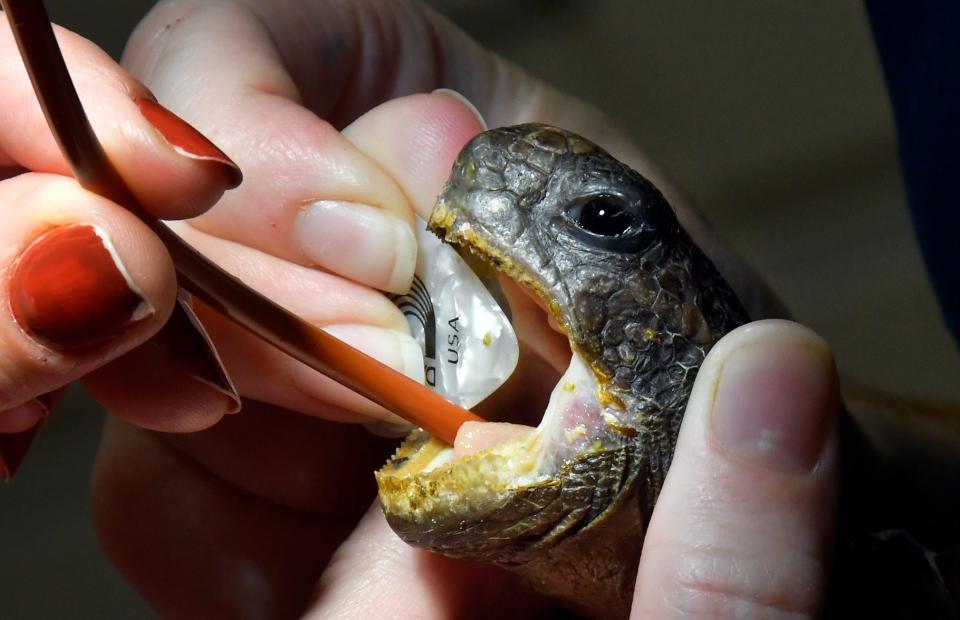
The Florida Wildlife Hospital grounds off U.S. 1 opened in 1998 and continue to expand in scope across a 5-acre rural spread. For example, crews have poured a concrete foundation for a future 50-foot raptor "flight cage" housing hawks and owls.
Executive Director Tracy Frampton, a former zookeeper, said her hospital does not handle alligators, manatees, venomous snakes, fish or sea turtles. Instead, patients last year included a bobcat, a peregrine falcon, a bald eagle, three white-tailed deer, eight Brazilian free-tailed bats, 536 cottontail rabbits, 667 opossums and 692 Eastern gray squirrels.
The hospital has 17 employees and recently hired its first-ever veterinarian, April Geer — who Frampton labels "a game-changer" — on Jan. 1 thanks to an anonymous donor. The nonprofit had previously partnered with Brevard Zoo for veterinary services.
About 80 volunteers worked 15,460 hours last year at the hospital, contributing an estimated $373,203 in free labor that powered facility operations.
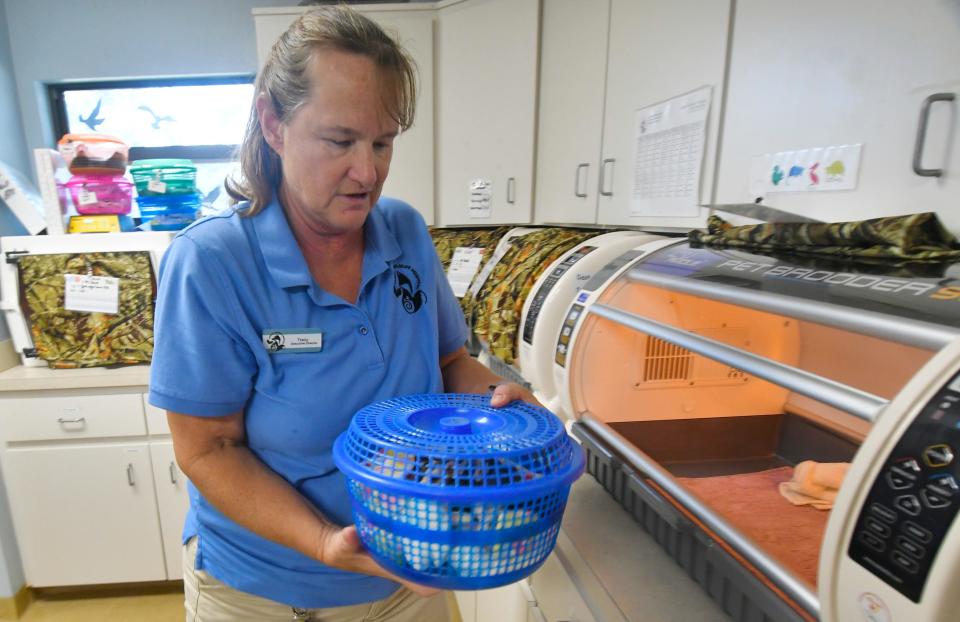
"A lot of people mistakenly believe that volunteering at a wildlife hospital means cuddling adorable animals. The truth is that our volunteers are doing lots of cleaning and manual labor," the hospital's 2022 annual report said.
"They are working outside in the extreme Florida heat, rain, or even hurricanes. They are driving for hundreds of miles to make sure we have the supplies we need and so animals get where they need to go. They are compassionately working with members of the public who are emotional over an animal in distress," the report said.
"They are getting bitten, scratched, and pooped on. They are writing until their hands cramp. And then they come back and do it again," the report said.
In December, FLORIDA TODAY honored Florida Wildlife Hospital as a finalist for Organization of the Year during the newspaper's 29th annual Volunteer Recognition Awards. Riley Renfro, an Eastern Florida State College student who volunteers at the animal hospital, was a finalist for Volunteer of the Year.
More: Focused on the aging, the hungry and helpless wildlife: Organization of the Year finalists
More: Volunteer of the year finalists make a difference in their communities
Palm Bay baby bunny rescue
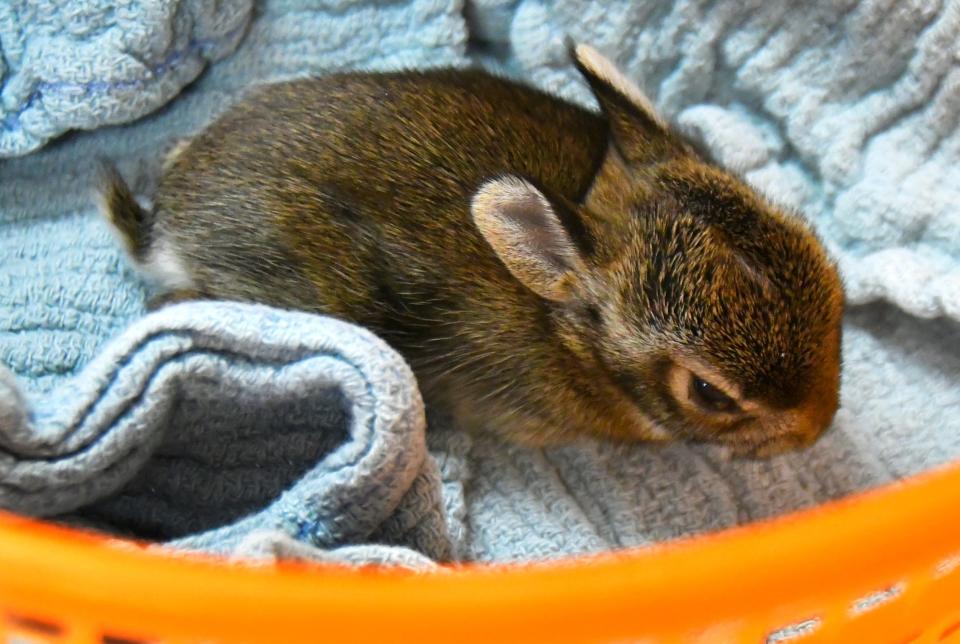
During a FLORIDA TODAY tour, Palm Bay resident Stephanie Wooley arrived in the hospital lobby carrying a white laundry basket. Nestled inside atop a beach towel was a helpless baby rabbit alongside a piece of organic celery.
Wooley's son, who owns a lawn business, discovered the tiny bunny that morning in a Palm Bay yard. Frampton carried the wee rabbit into the animal intake room.
"They're going to do an exam and see if there's any injuries. They're going to check the mucous membranes. They check the body condition. They'll even check to see if it's been nursing," Frampton told Wooley.
"We like to let everything calm down first — because it's just been through an alien abduction. So that's why it's in the intake room. It's got a white-noise machine in there, and we let it calm down. Then the medical team will take a look," she said.
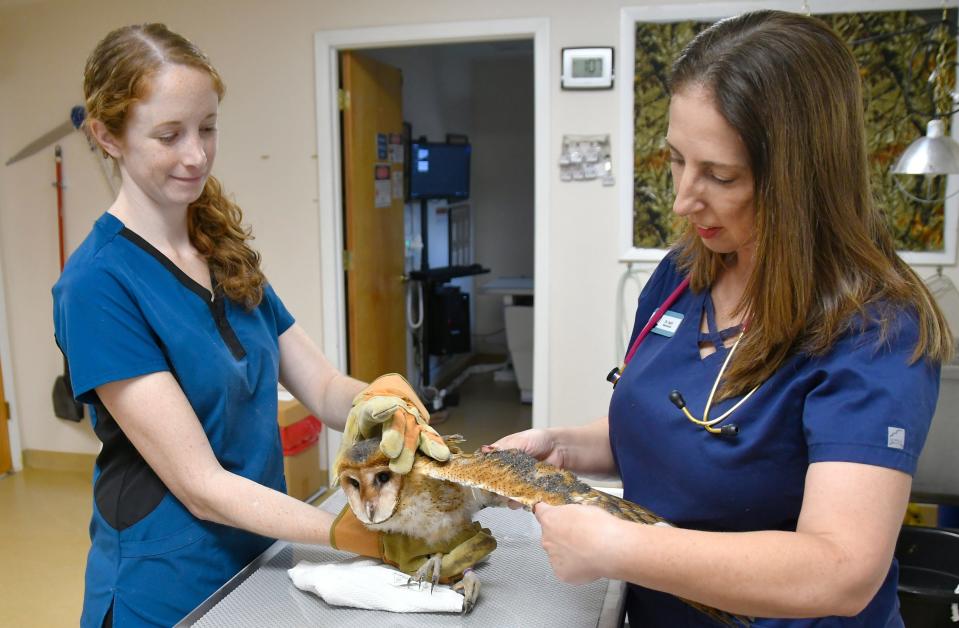
The hospital staffs a nursery for baby animals and a kitchen where volunteers prep a diverse menu of meals (for example, opossums and skunks are fed cat food, chopped vegetables, eggs, fish, mealworms and crickets).
The critical care unit features an X-ray machine, a laser therapy machine (useful for healing cracked turtle and tortoise shells), IV bags and a variety of medical equipment. Quiroz reached for a table and picked up a wadded-up section of black plastic garden netting.
"A lady brought this in with two black racer snakes stuck in it. Two of them," she said.
Luckily, Quiroz said hospital staffers freed one snake without incident and returned it to its habitat. But the other reptile suffered scratches and lacerations, so it was admitted as a patient.
"We see this kind of stuff every day. Nets. Fishing hooks. Getting run over by a car," Quiroz said.
"You know, it's sad. Because (these are) human-caused," she said.
Animals struggle for survival
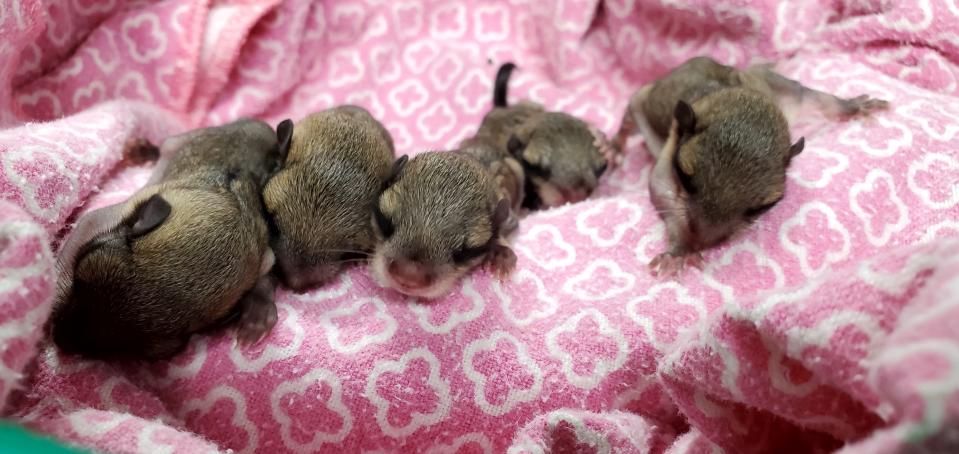
Inside an incubator, a pint-sized 4- to 6-week-old gopher tortoise remained lethargic after it blundered into a fire ant nest — suffering a painful biting attack just north of the U.S. 1-Pineda Causeway overpass.
The hapless tortoise went into anaphylactic shock. Hospital staffers treated it with antibiotics, anti-inflammatory medication and subcutaneous fluids. Peering into its incubator, Geer expressed optimism upon seeing the animal wriggle.
"He, initially for the first two to three days, hasn't been moving at all. So we're pretty excited to see him just do that little bit of movement," Geer said.
"It's a big step for him," Groover said, laughing.
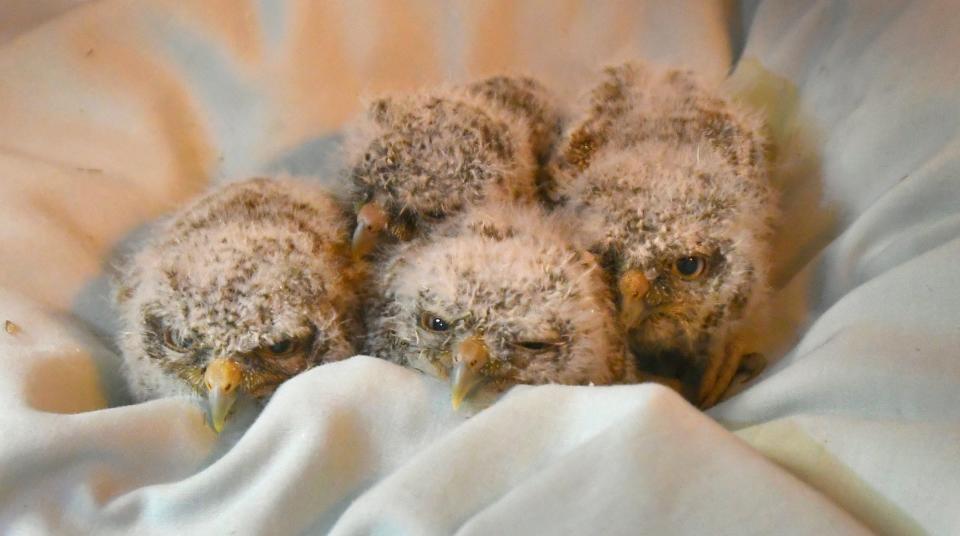
Elsewhere, a young Eastern screech owl peeked with wide yellow eyes from the upper-left corner of its metal cage, pinned with blue blankets for privacy. Labeled Patient ID No. 23-1391, this 100-gram owl was admitted April 10; is taking anti-inflammatory and pain-relieving medications; and eats one mouse in the morning and two every afternoon.
"These are certain animals that need daily, hourly, 15-minute care," Quiroz said.
Not all patient stories have happy endings. Minutes later during the FLORIDA TODAY tour, Geer and Groover quickly cleared the examination table for a medical emergency: a large, bleeding Florida softshell turtle that may have been struck by a vehicle.
Greer held a Doppler monitor against the turtle's long, snakelike neck to listen for sounds of blood flow, but could not detect any. Groover covered the deceased reptile in a white towel and carried it out of the room.
Otters, chimney swifts and bobcats
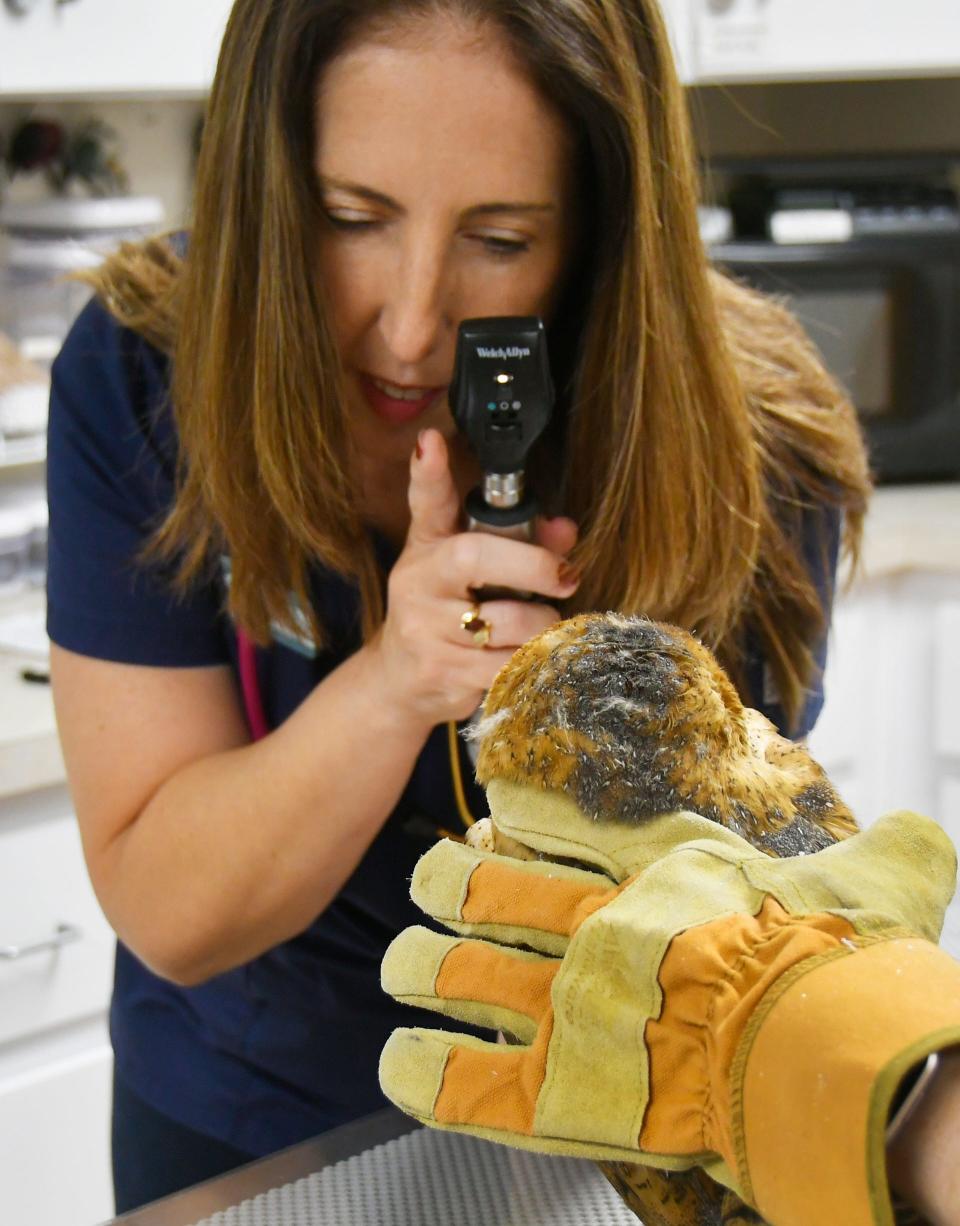
Outside, the Florida Wildlife Hospital property off U.S. 1 resembles a barnyard peppered with an array of animal enclosures. These heavy-duty cages are designed to accommodate a multitude of inhabitants, including otters, chimney swifts, bobcats and screech owls.
An aging "workshop" building houses laundry machines, freezers, refrigerators and an outdoor bird isolation area — deadly avian influenza has triggered extra precautionary measures in recent months.
Contaminated tableware, such as raccoon feeding dishes, are washed here as well. Because they can carry pathogens, raccoons are housed away from other animals near the western edge of the property.
Case in point: A raccoon prompted the Florida Department of Health in Brevard County to issue an ongoing 60-day rabies alert across most of Port St. John.
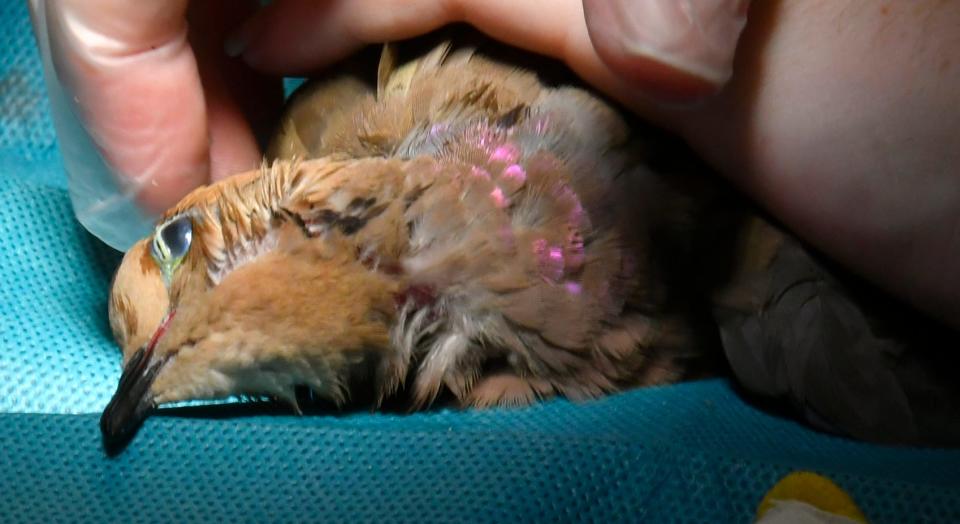
A short walk from the workshop, Quinn the red-shouldered hawk emitted whining squawks from his wooden enclosure. Crippled by a deformed right foot — "we think something entangled around his toes while he was in the nest," Frampton said — he is a permanent feathered resident. He also serves as an "ambassador" by appearing across the Space Coast at public educational demonstrations.
Nearby, an octagonal enclosure houses flying squirrels and a box turtle. Joy Arnold of Cocoa Beach sat outside on a large cinder block, watching a shelled creature loiter in the grass a few feet away.
"Joy is doing a grueling task that many of our volunteers do — she's walking a tortoise," Frampton said. "It's really important that they get the ultraviolet light every day.
"We actually have a rule: You're not allowed to have your phone on you. Because it's tempting to be playing on your phone, and then you look up and the tortoise is gone," Frampton said.
"They will book it," she said.
What if I find an injured animal?
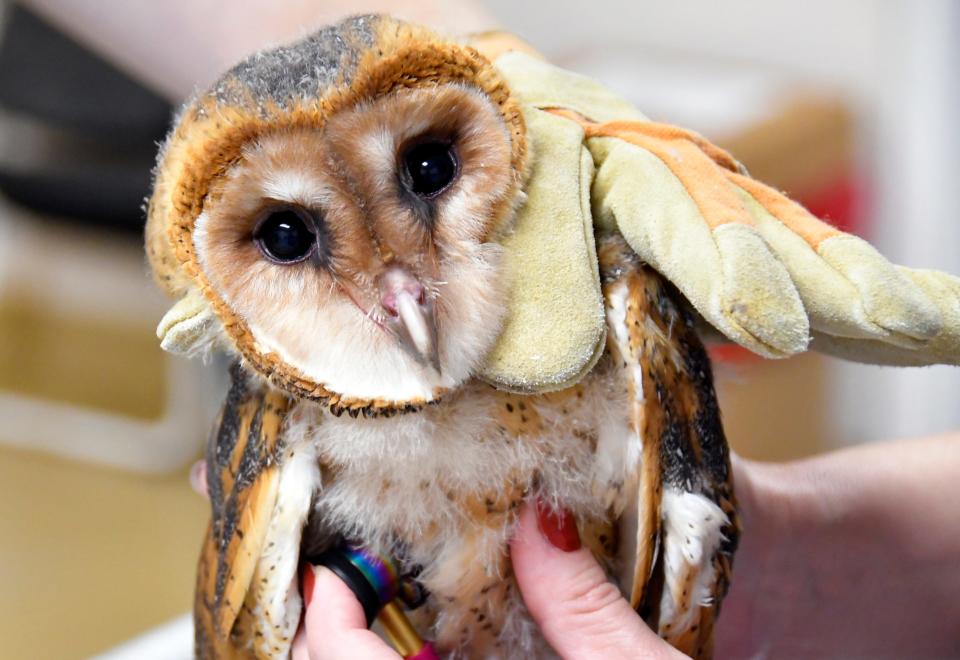
Florida Wildlife Hospital staff are available daily from 9 a.m. to 4:30 p.m. at 321-254-8843 to help with wildlife issues. Leave a message if no one answers. Calls are usually returned within 30 minutes to an hour during office hours.
Five "after-hours" cages in the parking lot let people drop off ailing and orphaned creatures between 4:30 p.m. and 9 a.m.
The "Found Animal" section of the nonprofit's website at floridawildlifehospital.org lists handling instructions for various species. Among the tips:
If you are uncomfortable handling the injured animal, call the hospital and a trained volunteer may be dispatched.
Do not handle raccoons, foxes, skunks, bats, otters, bobcats or unknown dogs and cats because of the risk of rabies.
If you find a baby squirrel that has tumbled out of its nest and does not appear injured, either find the nest and put it back or leave the baby at the base of the tree.
Put non-venomous snakes in an old pillow case and close with a rubber band or knot, then place it in a box with air holes or no lid.
"We don't have enough volunteers or staff to go out and make rescues. So if you can safely bring that hurt animal to us, that's what we'd like," Quiroz told tour visitors.
"If you can't, if it's something big or scary — a sandhill crane, a hawk, whatever — call us and we'll figure out how to do that together."
Limited 50th anniversary tours available
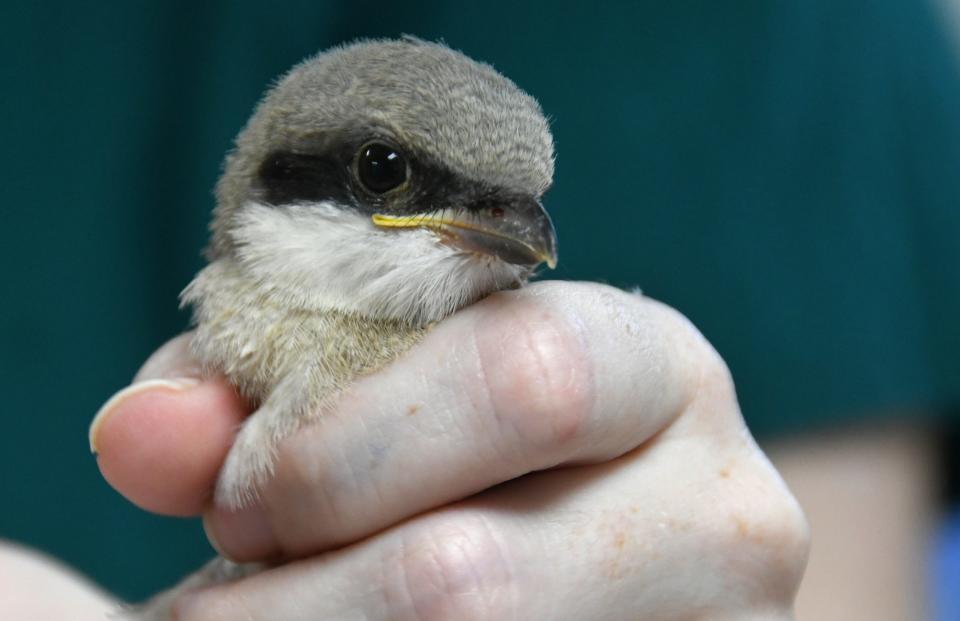
Florida Wildlife Hospital is offering limited 30-minute behind-the-scenes tours on June 20, July 18 and Aug. 15.
Cost is $15 for the general public. Reservations are required by calling 321-254-8843.
Rick Neale is the South Brevard Watchdog Reporter at FLORIDA TODAY (for more of his stories, click here.) Contact Neale at 321-242-3638 or rneale@floridatoday.com. Twitter: @RickNeale1
Support local journalism. Subscribe today.
This article originally appeared on Florida Today: Florida Wildlife Hospital marks 50th anniversary on the Space Coast

